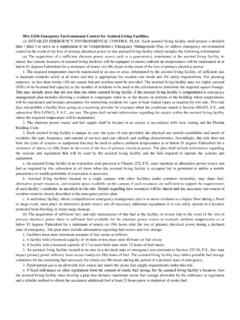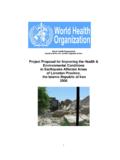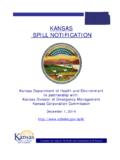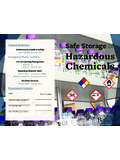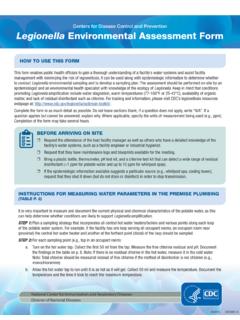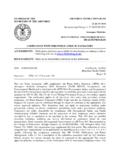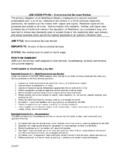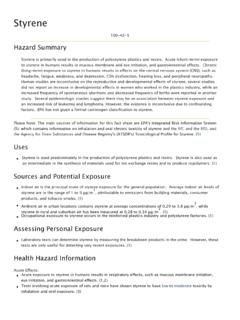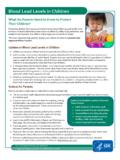Transcription of FOR THE P uBl IC HE al TH M GEME T OF CHIEMIC I
1 Crisis communicationrisk assessment Department of Public health and EnvironmentWorld health Organization20, Avenue AppiaCH-1211 Geneva the Public health Management of Chemical IncidentsManualplanning emergency preparedness Manual FOR THE PuBlIC health ManaGEMEnT OF CHIEMICal InCIDEnTShazardISBN 9 789241 598149for the Public health Management of Chemical IncidentsManualWHO Library Cataloguing-in-Publication DataManual for the public health management of chemical incidents. 1. Hazardous substances. 2. Environmental exposure adverse effects. 3. Environmental exposure prevention and control. 4. Environmental monitoring. 5. Risk assessment. 6. Data collection. 7. Public health practice. 8. Manuals. I. world health 978 92 4 159814 9 (NLM classification: WA 670) world health organization 2009 All rights reserved. Publications of the world health organization can be obtained from WHO Press, world health organization , 20 Avenue Appia, 1211 Geneva 27, Switzerland (tel.)
2 : +41 22 791 3264; fax: +41 22 791 4857; e-mail: Requests for permission to reproduce or translate WHO publications whether for sale or for noncommercial distribution should be addressed to WHO Press, at the above address (fax: +41 22 791 4806; e-mail: The designations employed and the presentation of the material in this publication do not imply the expression of any opinion whatsoever on the part of the world health organization concerning the legal status of any country, territory, city or area or of its authorities, or concerning the delimitation of its frontiers or boundaries. Dotted lines on maps represent approximate border lines for which there may not yet be full mention of specific companies or of certain manufacturers products does not imply that they are endorsed or recommended by the world health organization in preference to others of a similar nature that are not mentioned.)
3 Errors and omissions excepted, the names of proprietary products are distinguished by initial capital reasonable precautions have been taken by the world health organization to verify the information contained in this publication. However, the published material is being distributed without warranty of any kind, either expressed or implied. The responsibility for the interpretation and use of the material lies with the reader. In no event shall the world health organization be liable for damages arising from its & Layout: L IV Com S rlPrinted by the WHO Document Production Services, Geneva, SwitzerlandCONTENTSPREFACE viACKNOWLEDGEMENTS viiiINTRODUCTION THE OBJECTIVE OF THIS PUBLICATION The epidemiology of chemical incidents SCOPE AND DEFINITIONS Injury mechanisms Examples of incident scenarios The disaster management cycle A chemical incident management structure CORE PUBLIC health FUNCTIONS Risk assessment Communication 14 PREVENTION PROTECTION LAYERS SCENARIO ANALYSIS AND IMPACT ASSESSMENT POLICY.
4 LEGISLATION AND ENFORCEMENT Land-use planning Licensing of hazardous sites and transport routes Building regulations Control of chemical transportation and storage Labour health and safety Establishment of a hazardous sites database 20 Control of waste disposal sites Control of contaminated environment Emergency planning and response Inspection of hazardous sites and transportation INTERNATIONAL REGULATIONS AND TOOLS Global agreements Regional agreements National laws International tools PREVENTION OF CHEMICAL HAZARDS FOR THE PUBLIC Public education and awareness Identification and protection of vulnerable populations ROLE OF PUBLIC AND ENVIRONMENTAL health AND OTHER AGENCIES IN INFLUENCING POLICIES AND LEGISLATION 27 EMERGENCY PLANNING AND PREPAREDNESS GATHERING USEFUL INFORMATION National hazardous sites database Chemical information databases health sector capabilities databases PREPARATION OF A CHEMICAL INCIDENT RESPONSE PLAN Framework for planning of the chemical emergency response Local emergency planning guidelines COMMUNITY IMPACT ASSESSMENT INCIDENT COMMAND COMMUNICATION Inter-agencies communication Risk and crisis communication information and public warnings BUILDING HUMAN CAPACITIES Training Exercises 43 DETECTION AND ALERT METHODS TO DETECT CHEMICAL INCIDENTS health AND ENVIRONMENT SURVEILLANCE Population health surveillance General health statistics Sentinel health events Challenges for population health surveillance Environmental monitoring ALERT CHANNELS 52iv Manual for the Public health ManageMent of cheMical incidentsRESPONSE TERMINATE RELEASE.
5 PREVENT SPREAD OF CONTAMINATION AND LIMIT EXPOSURE ACTIVATE THE PUBLIC health RESPONSE Activating a response Advising and alerting medical services Activating inter-agency communication CONDUCT AN INITIAL ASSESSMENT AND ADVISE STAKEHOLDERS ENSURE COORDINATION AND INTEGRATION OF THE PUBLIC health RESPONSE CONDUCT A BEST OUTCOME ASSESSMENT FOR BOTH IMMEDIATE AND LONG-TERM ACTIONS DISSEMINATE INFORMATION AND ADVICE TO PUBLIC, MEDIA AND RESPONDERS REGISTER ALL EXPOSED INDIVIDUALS AND COLLECT SAMPLES TO ESTIMATE EXPOSURE CONDUCT INVESTIGATIONS DURING THE INCIDENT 64 RECOVERY VICTIM SUPPORT RISK AND health OUTCOME ASSESSMENTS Registration Population exposure assessment Environmental assessment health outcome assessment during or immediately after the incident Intermediate and long-term effects of the incident IMPLEMENTING REHABILITATION ACTIONS Remediation Restoration Rehabilitation of public health and livelihood PREVENTION OF INCIDENT RECURRENCE Causative factors analysis Evaluation of the response to the incident CONTRIBUTION TO THE INFORMATION OF THE INTERNATIONAL COMMUNITY 84 GLOSSARY 87 vPREFACEC hemical releases arising from technological incidents, natural disasters, and from conflict and terrorism are common.
6 The International Federation of the Red Cross has estimated that between 1998 and 2007, there were nearly 3 200 technological disasters with approximately 100 000 people killed and nearly 2 million people affected. The production and use of chemicals is predicted to increase worldwide, and this is particularly true in developing countries and those with economies in transition where increased chemical extraction, processing and use is closely tied to economic development. An ever increasing dependency on chemicals requires the health sector to expand its traditional roles and responsibilities to be able to address the public health and medical issues associated with the use of chemicals and their health effects. A number of important international initiatives have recently been undertaken that require countries to strengthen capacities in relation to the health aspects of chemical incidents and emergencies:In 2005, the revised International health Regulations (IHR (2005)) were adopted by the world health Assembly.
7 Entering into force in 2007, IHR (2005) is a legally binding agreement contributing to international public health security by providing a framework for the coordination of the management of events that may constitute a public health emergency of international concern, and for strengthening the capacity of all countries to detect, assess, notify and respond to public health threats. Initially developed for certain infectious diseases, the revised IHR (2005) also covers those public health threats involving 2006, the Strategic Approach for International Chemicals Management (SAICM) was adopted by the International Conference on Chemicals Management. SAICM provides a policy framework to promote chemical safety around the world , including many aspects of chemical incident prevention and preparedness. It comprises the Dubai Declaration expressing high-level political commitment to SAICM and an Overarching Policy Strategy which sets out its scope, needs, objectives, financial considerations, underlying principles and approaches and implementation and review arrangements.
8 The Declaration and Strategy are accompanied by a Global Plan of Action that serves as a working tool and guidance document to support implementation of the purpose of the WHO Manual for the Public health Management of Chemical Incidents is to provide a comprehensive overview of the principles and roles of public health in the management of chemical incidents and emergencies. While this information is provided for each phase of the emergency cycle, including prevention, planning and preparedness, detection and alert, response and recovery, it is recognized that the management of chemical incidents and emergencies require a multi-disciplinary and multi-sectoral approach and that the health sector may play an influencing, vi Manual for the Public health ManageMent of cheMical incidentscomplementary or a leadership role at various stages of the management process.
9 The target audience includes public health and environmental professionals, as well as any other person involved in the management of chemical incidents. WHO and all those involved in the development of the publication hope that the publication will have wide application, especially in developing countries and countries with economies in transition, and that in the future the health sector will be better prepared to acknowledge and fulfil its roles and responsibilities in the management of chemical incidents and emergencies, thereby contributing to the prevention and mitigation of their health FOR DEVELOPMENT OF THE MANUALDr K. Gutschmidt, WHO Secretariat, served as the Responsible Officer for the development of this manual including its scientific editorial group of scientific experts was convened by WHO to provide oversight, expertise, and guidance for the project and to ensure its scientific accuracy and objectivity.
10 Editorial members included Professor G. Coleman (Director, WHO Collaborating Centre for the Public health Management of Chemical Incidents, Cardiff, United Kingdom), Professor S. Palmer and Dr D. Russell (both health Protection Agency, United Kingdom). The editorial group met several times in Cardiff and Geneva during 2007 2009 to define the scope, content and structure of the manual, to review and discuss the content and to oversee implementation of the first draft was prepared by Dr D. MacIntosh (Environmental health & Engineering, Newton, MA, USA) and posted on the internet for peer-review in February 2007. In addition, a review meeting taking into account comments received was held on 23 25 April 2007, Beijing, China. The meeting was attended by Professor G. Coleman (chair), Dr A.










